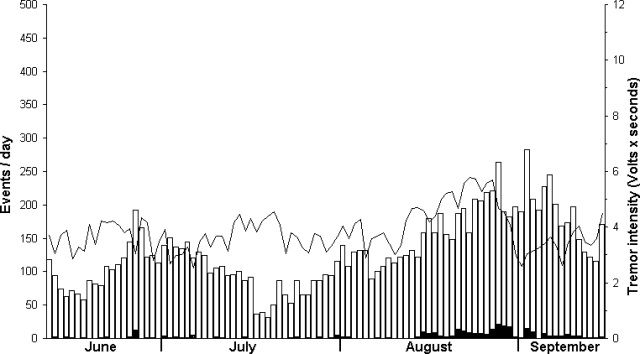Report on Stromboli (Italy) — August 1995
Bulletin of the Global Volcanism Network, vol. 20, no. 8 (August 1995)
Managing Editor: Richard Wunderman.
Stromboli (Italy) Seismicity generally low from mid-June to mid-September
Please cite this report as:
Global Volcanism Program, 1995. Report on Stromboli (Italy) (Wunderman, R., ed.). Bulletin of the Global Volcanism Network, 20:8. Smithsonian Institution. https://doi.org/10.5479/si.GVP.BGVN199508-211040
Stromboli
Italy
38.789°N, 15.213°E; summit elev. 924 m
All times are local (unless otherwise noted)
The only significant tremor variations for the period 11 June-15 September 1995 were between 12 and 27 August, when intensity slowly increased (figure 45). The following four days were characterized by a rapid return of the intensity to the range observed throughout the first half of September. Noteworthy is the lack of a great number of saturating events compared to March-May 1995, including the 5 March explosion (BGVN 20:04 and 20:05). This means that explosive activity was either less energetic or shallower, with more energy released towards the air than into seismic waves. The total number of recorded events showed a rise and subsequent decrease from mid-June to mid-July, with two minima of 50-60 events/day and a maximum of almost 200 events/day recorded on 26 June. Another rise starting in mid-July reached values of 260-280 events on 28 August and 3 September, corresponding to the period of decreased tremor.
Geological Summary. Spectacular incandescent nighttime explosions at Stromboli have long attracted visitors to the "Lighthouse of the Mediterranean" in the NE Aeolian Islands. This volcano has lent its name to the frequent mild explosive activity that has characterized its eruptions throughout much of historical time. The small island is the emergent summit of a volcano that grew in two main eruptive cycles, the last of which formed the western portion of the island. The Neostromboli eruptive period took place between about 13,000 and 5,000 years ago. The active summit vents are located at the head of the Sciara del Fuoco, a prominent scarp that formed about 5,000 years ago due to a series of slope failures which extends to below sea level. The modern volcano has been constructed within this scarp, which funnels pyroclastic ejecta and lava flows to the NW. Essentially continuous mild Strombolian explosions, sometimes accompanied by lava flows, have been recorded for more than a millennium.
Information Contacts: Roberto Carniel, Dipartimento di Georisorse e Territorio, via Cotonificio 114, I-33100 Udine, Italy.


